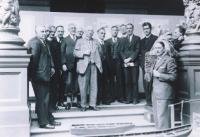American left liberalism in Ireland
Published in 20th Century Social Perspectives, 20th-century / Contemporary History, General, Issue 2 (March/April 2013), Letters, Volume 21
In the photo of the Irish Folklore Commission’s visit to the National Museum in 1937 (HI 21.1, Jan./Feb. 2013, TV Eye, p.51), Hans Hartmann was incorrectly identified as being sixth from left; he is in fact fifth from right. From left to right are: Prof. James Delargy, Seán Forde, Fr Eric Mac Fhinn, Dr Adolf Mahr (director, National Museum), Osborn Bergin, Liam Price, Peadar McGinley, Eamonn O’Donoghue, León Ó Broin, Hans Hartmann, Louis Maguire, Revd John G. O’Neill, Ake Campbell and Michael Heany. (Dept. of Folklore, UCD)
Sir,—It is normal for national historians, in the narration of the history of their nation, to mention or recount, in due place, the intrusion, progress and influence of a foreign ideology or world-view. Irish national historians have done this, successively, in the cases of the arrival and impact of Christianity, the Anglo-Norman invasion, Continental Catholicism, Protestantism, the English legal system, French republicanism, British classical liberalism, Victorianism, Catholic Ultramontanism and socialism. Hence my puzzlement at the absence of any treatment, in the Irish historians’ accounts I have seen, of the principal foreign ideological penetration of Ireland in the past half-century. I mean that of American left liberalism, which, with its new set of dos, don’ts and do-as-you-likes for behaviour, thought and language, has become—with the support of Irish legislation—the Republic’s reigning ideology. The fact that since the 1960s/70s this American ideological colonisation has produced the reigning ideology of western Europe generally takes nothing from the fact that its arrival via London, and takeover in Ireland, have been a substantial part of our recent national history. Omitting an account of this from our historical narrative has been equivalent to Romanian or Hungarian historians failing (unimaginably) to recount the arrival and implementation of Russian Communist ideology in those countries from the 1940s to the late 1980s. Can anyone, beginning with our historians, explain this remarkable omission from the Irish historical narrative?—Yours etc.,
















